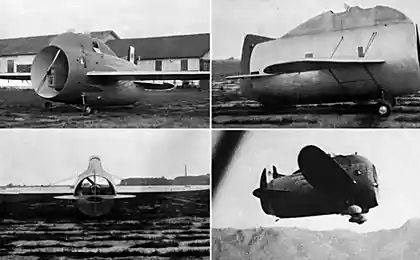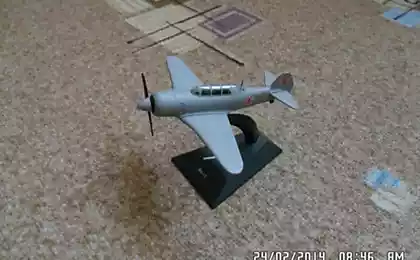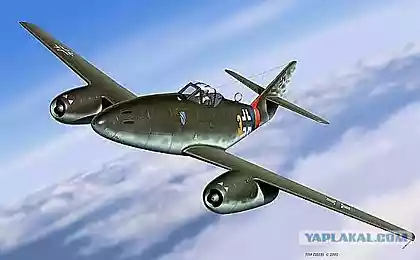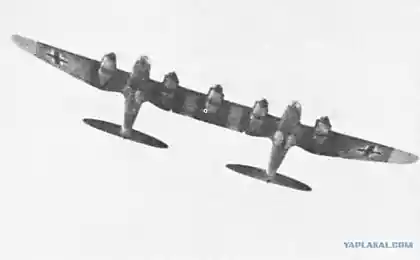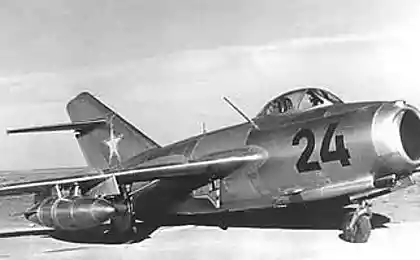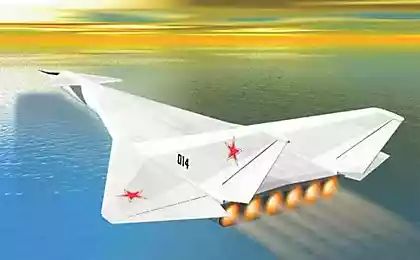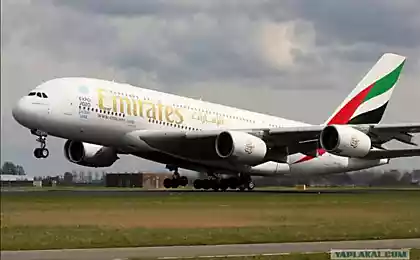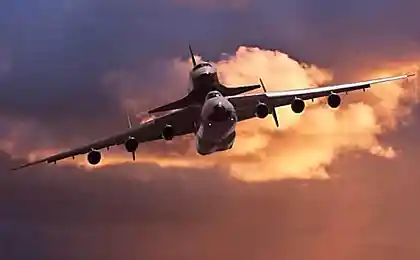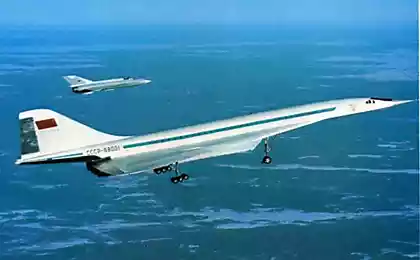457
How would look like the plane is flying at a speed of 25 600 km/h?
To get from Moscow to new York in half an hour — it's something from the category of fiction. In geography, the antipode is a place on Earth, United with the specified point by a straight line passing through the center of the planet. That is the place that is strictly on the other side of the world. And yet it's the furthest point from you. If you are in the UK, that word denotes Australia and New Zealand heading the longest flights. Time of flight on a normal plane from London to Auckland, the largest city in New Zealand, it is about 24 hours with one stop.
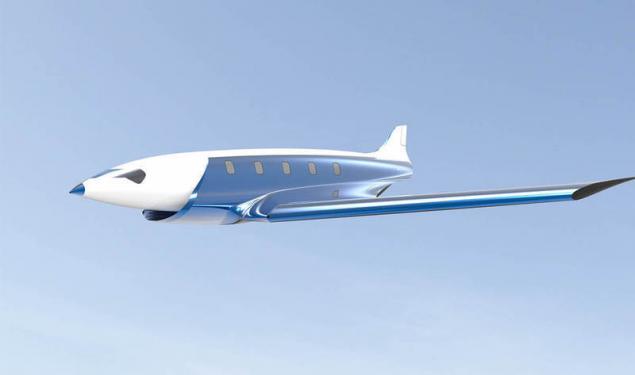
Now imagine a plane that could make this trip in less than half an hour. There would be a revolution in the field of Aeronautics. But to accomplish this, we probably would have had to violate the laws of physics, or at least aerodynamics?
One inventor does not think so. And he called his conceptual supersonic aircraft "antithesis": Antipode.
"The idea is to get from new York to London in twenty minutes — she gets the people really," says canadian designer Charles Bombardier, responding to a BBC question about the reaction of people to his concept. "This is essentially what people always wanted: a transportation system that can take you from one place to the other end of the planet."
Bombardier is known for its big ideas and bold concepts. On its website it says that the Antipode should be a supersonic business jet that can reach speeds of about 25 to 600 km/h, or Mach 24. For comparison, the Concorde reached a speed of slightly more than Mach 2 (about 2560 km/h). The aircraft must be removed from the space using rocket boosters. They will provide the initial impetus that will lead the aircraft to a height of 12 kilometers and a speed of 5 Mach. Then step off and RAMJET will take over the acceleration to Mach 24.
"I needed to accelerate the plane to Mach 5, and I think RAMJET will begin to operate efficiently at this speed, so came the idea to use rockets," says Bombardier. Then rocket boosters back to the airfield for re-use — like the one recently demonstrated by Elon Musk.
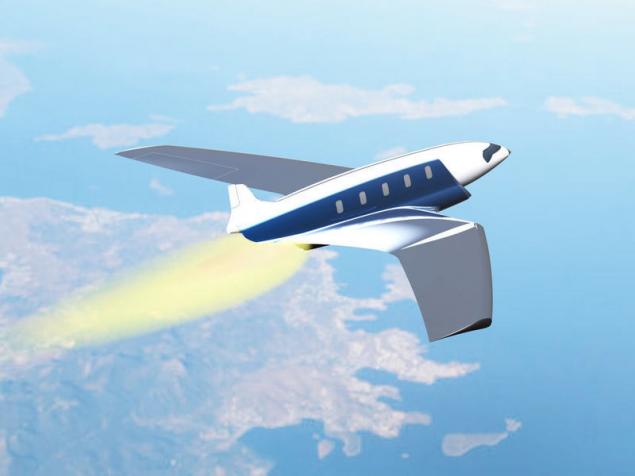
At such incredible speed the plane is more like a hurtling projectile than on conventional aircraft and the wings in the conceptual design reflects this. They provide sufficient lift and descent on the 2-km long runway, the usual. However, if the aircraft need a second attempt to enter the gate, he will need to activate the compact rocket boosters to accelerate. From rocket stages also has a second useful application: they can be used to slow the aircraft, if you send them in the opposite direction of the movement direction.
Projects Bombardier to build aircraft 10 times faster than the "Concorde" should be viewed skeptically, but he admits that it is only a concept, designed to stir up interest and discussion of potential technologies. However, some serious problems he considered himself.
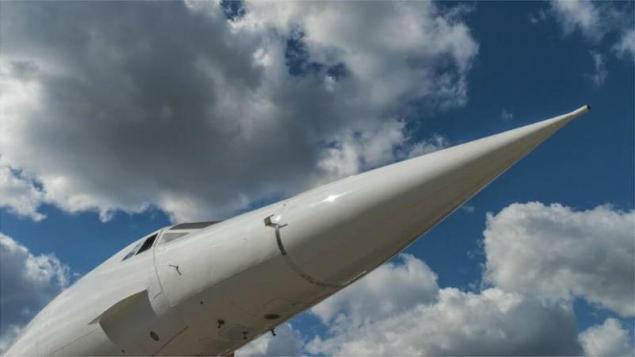
Earlier the concept Skreemr was designed to score 10 swings. This aircraft would be faced with the same problems as the "Concord" loud sonic boom over land, the potential accumulation of heat along the leading edges of the nose and the wing due to air resistance at high speed. But after he published his design and has attracted interest, he was contacted by Joseph Hazelton, engineer Wyle, providing technical advice to NASA.
Wyle offers a new technology — LPM, Long Penetration Mode ("continuous penetration").
Through a nozzle in the bow will be discharged air, which produces a counter flow jet. This aerodynamic phenomenon can, in theory, reduce sonic boom and cool the surface, breaking vozduhom. Experiments in the wind tunnel showed that it could work.
Even the new technology of the type LPM will not reduce the heating to zero, and the RAMJET engines have yet to develop until, until they become commercially viable. Incredible acceleration can also lead to problems for passengers.
Anyway, while this is just a concept, not a practical idea.
But this concept at least contributes to the development. published
Source: hi-news.ru/technology/kak-mog-by-vyglyadet-samolet-letayushhij-so-skorostyu-25-600-kmch.html

Now imagine a plane that could make this trip in less than half an hour. There would be a revolution in the field of Aeronautics. But to accomplish this, we probably would have had to violate the laws of physics, or at least aerodynamics?
One inventor does not think so. And he called his conceptual supersonic aircraft "antithesis": Antipode.
"The idea is to get from new York to London in twenty minutes — she gets the people really," says canadian designer Charles Bombardier, responding to a BBC question about the reaction of people to his concept. "This is essentially what people always wanted: a transportation system that can take you from one place to the other end of the planet."
Bombardier is known for its big ideas and bold concepts. On its website it says that the Antipode should be a supersonic business jet that can reach speeds of about 25 to 600 km/h, or Mach 24. For comparison, the Concorde reached a speed of slightly more than Mach 2 (about 2560 km/h). The aircraft must be removed from the space using rocket boosters. They will provide the initial impetus that will lead the aircraft to a height of 12 kilometers and a speed of 5 Mach. Then step off and RAMJET will take over the acceleration to Mach 24.
"I needed to accelerate the plane to Mach 5, and I think RAMJET will begin to operate efficiently at this speed, so came the idea to use rockets," says Bombardier. Then rocket boosters back to the airfield for re-use — like the one recently demonstrated by Elon Musk.

At such incredible speed the plane is more like a hurtling projectile than on conventional aircraft and the wings in the conceptual design reflects this. They provide sufficient lift and descent on the 2-km long runway, the usual. However, if the aircraft need a second attempt to enter the gate, he will need to activate the compact rocket boosters to accelerate. From rocket stages also has a second useful application: they can be used to slow the aircraft, if you send them in the opposite direction of the movement direction.
Projects Bombardier to build aircraft 10 times faster than the "Concorde" should be viewed skeptically, but he admits that it is only a concept, designed to stir up interest and discussion of potential technologies. However, some serious problems he considered himself.

Earlier the concept Skreemr was designed to score 10 swings. This aircraft would be faced with the same problems as the "Concord" loud sonic boom over land, the potential accumulation of heat along the leading edges of the nose and the wing due to air resistance at high speed. But after he published his design and has attracted interest, he was contacted by Joseph Hazelton, engineer Wyle, providing technical advice to NASA.
Wyle offers a new technology — LPM, Long Penetration Mode ("continuous penetration").
Through a nozzle in the bow will be discharged air, which produces a counter flow jet. This aerodynamic phenomenon can, in theory, reduce sonic boom and cool the surface, breaking vozduhom. Experiments in the wind tunnel showed that it could work.
Even the new technology of the type LPM will not reduce the heating to zero, and the RAMJET engines have yet to develop until, until they become commercially viable. Incredible acceleration can also lead to problems for passengers.
Anyway, while this is just a concept, not a practical idea.
But this concept at least contributes to the development. published
Source: hi-news.ru/technology/kak-mog-by-vyglyadet-samolet-letayushhij-so-skorostyu-25-600-kmch.html
